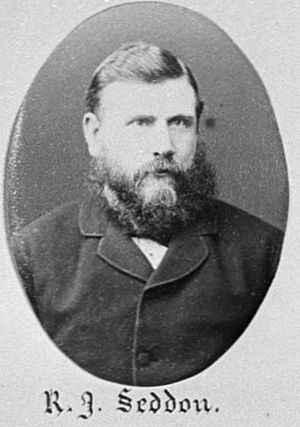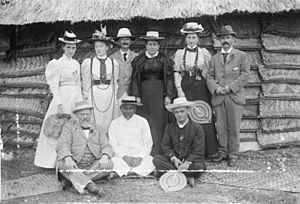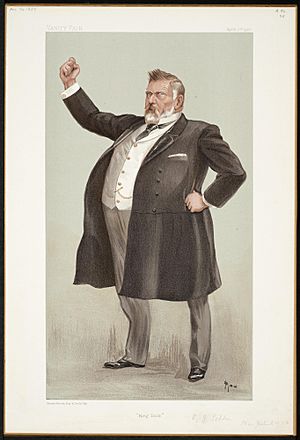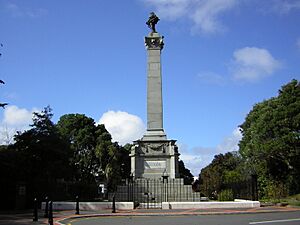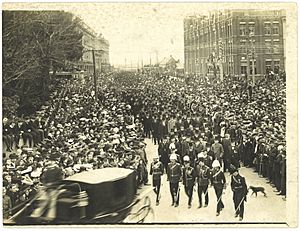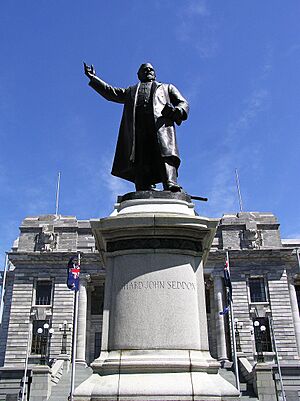Richard Seddon facts for kids
Quick facts for kids
Richard John Seddon
|
|
|---|---|
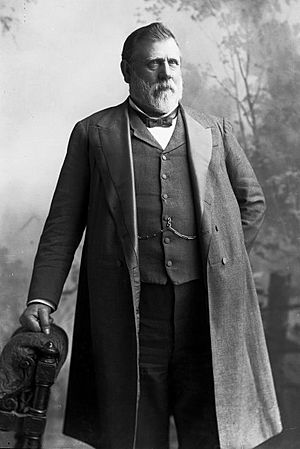
Seddon in 1905
|
|
| 15th Prime Minister of New Zealand | |
| In office 27 April 1893 – 10 June 1906 |
|
| Monarch | Victoria Edward VII |
| Governor | David Boyle Uchter Knox William Plunket |
| Preceded by | John Ballance |
| Succeeded by | William Hall-Jones |
| 8th Minister of Defence | |
| In office 23 January 1900 – 10 June 1906 |
|
| Prime Minister | Himself |
| Preceded by | Thomas Thompson |
| Succeeded by | Albert Pitt |
| In office 24 January 1891 – 22 June 1896 |
|
| Prime Minister | John Ballance |
| Preceded by | William Russell |
| Succeeded by | Thomas Thompson |
| 11th Minister of Public Works | |
| In office 24 January 1891 – 2 March 1896 |
|
| Prime Minister | John Ballance |
| Preceded by | Thomas Fergus |
| Succeeded by | William Hall-Jones |
| 7th Minister of Mines | |
| In office 24 January 1891 – 6 September 1893 |
|
| Prime Minister | John Ballance |
| Preceded by | Thomas Fergus |
| Succeeded by | Alfred Cadman |
| Member of the New Zealand Parliament for Westland |
|
| In office 5 December 1890 – 10 June 1906 |
|
| Preceded by | Electorate created |
| Succeeded by | Tom Seddon |
| Member of the New Zealand Parliament for Kumara |
|
| In office 9 December 1881 – 5 December 1890 |
|
| Preceded by | Electorate created |
| Succeeded by | Electorate abolished |
| Member of the New Zealand Parliament for Hokitika |
|
| In office 5 September 1879 – 9 December 1881 |
|
| Preceded by | Multi-member electorate |
| Succeeded by | Gerard George Fitzgerald |
| Personal details | |
| Born | 22 June 1845 Eccleston, Lancashire, England |
| Died | 10 June 1906 (aged 60) At sea |
| Resting place | Bolton Street Memorial Park |
| Political party | Independent (1879–91) Liberal (1891–1906) |
| Spouse | Louisa Jane Spotswood (m. 1869) |
| Children | 9, including Tom Seddon and Elizabeth Gilmer |
| Signature |  |
Richard John Seddon (born 22 June 1845 – died 10 June 1906) was a New Zealand politician. He served as the 15th Prime Minister of New Zealand from 1893 until his death. He was in office for 13 years. This makes him New Zealand's longest-serving head of government ever.
Seddon was born in Eccleston, England. He moved to New Zealand in 1866 to join his uncle in the goldfields. He became well-known in local politics. This led him to win a seat in the House of Representatives in 1879. Seddon became an important member of the Liberal Party. He became the leader after John Ballance died in 1893.
Seddon's government brought many social and economic changes. These included the introduction of old-age pensions. He was very popular and a strong leader. He helped New Zealand support Britain in the Second Boer War. He also helped New Zealand take control of the Cook Islands in 1901. Seddon died while still in office.
Seddon was known for focusing on his home region, the West Coast. He was seen as a strong fighter for the people there. He was sometimes called "King Dick" because of his powerful leadership style. Despite some criticisms, he is remembered as one of New Zealand's most important politicians.
Contents
Early Life and Moving to New Zealand
Richard Seddon was born in Eccleston, England, on 22 June 1845. His father, Thomas Seddon, was a school headmaster. His mother, Jane Lindsay, was a teacher. Richard was the third of their eight children.
Richard did not do well at school. He was described as a bit wild. He left school at age 12. He worked on his grandfather's farm for two years. Then he became an apprentice at a foundry, learning engineering. He later worked at another foundry in Liverpool. He earned a certificate as a mechanical engineer.
At 16, in 1862, Seddon decided to move to Australia. He felt restless and wanted to see new lands. He worked in railway workshops and goldfields there. But he did not find much success. In 1865 or 1866, he got engaged to Louisa Jane Spotswood. But her family wanted him to be financially stable first.
Seddon moved to New Zealand's West Coast in 1866. He worked in the goldfields in Waimea. He did well there and went back to Melbourne to marry Louisa. He then opened a store and later a pub. His older sister and two younger brothers also followed him to the West Coast.
Getting Started in Politics
Seddon first got involved in politics in 1870. He tried to join the Westland County Council but did not win. That same year, he was elected to the Arahura Road Board. In 1874, he was elected to the Westland Provincial Council. He became known for speaking up for miners. He also cared about education.
When the provinces were removed in 1876, he lost this job. But he was then elected to the county council. In 1877, he became the first Mayor of Kumara. Kumara was a busy gold mining town. Even though he had some money problems, his political career grew.
Entry to Parliament
In the 1879 election, Seddon was elected to Parliament. He represented Hokitika until 1881. Then he represented Kumara from 1881 to 1890. Finally, he represented Westland from 1890 until his death in 1906. His son, Tom Seddon, later took over his seat for Westland.
In Parliament, Seddon joined with George Grey, a former Governor. Many members of Parliament made fun of Seddon at first. They mocked his accent and his lack of formal education. But Seddon was good at stopping laws he didn't like. He focused on issues important to his West Coast voters. He became an expert on mining issues.
He often spoke about helping "the common man" against rich people and landowners. He said, "It is the rich and the poor; it is the wealthy people and the landowners against the middle classes and the labouring classes."
Joining the Liberal Party
Seddon joined the new Liberal Party after the 1890 election. The party wanted to make changes in land and labour laws. They were helped by a new rule that stopped landowners from voting in every district they owned land in.
In January 1891, the Liberals came to power. Seddon became a minister for the first time. He was in charge of public works, mines, defence, and marine. He pushed for a system where groups of workers could do public works projects like building roads.
Seddon was not tied to one strong political idea. He saw the Liberals as champions for ordinary New Zealanders. He was very popular because he strongly supported their interests. People who opposed him often focused on his lack of education. This actually made him seem even more like a hero to ordinary people.
Seddon quickly became popular across the country. However, some of his colleagues were not happy. They thought he cared more about being popular than about what was right. John Ballance, the Premier, believed strongly in things like women's suffrage (the right for women to vote) and Māori rights. Seddon was not always as keen on these ideas. But many in the Liberal Party saw Seddon's popularity as a big help for the party.
Becoming Prime Minister

In 1892, John Ballance became very ill. Seddon took over as acting leader of the House. After Ballance died in April 1893, the Governor asked Seddon to form a new government. Seddon became the temporary leader of the Liberal Party. He promised a full vote on the leadership later.
However, Seddon managed to stay in charge. He convinced his party that a leadership fight would divide them. This helped him keep the top job. Robert Stout, a former Premier, was his main challenger. Stout believed in strong liberal ideas, like Ballance. But Seddon stayed in power. Stout later left the Liberal Party in 1896.
Key Changes and Policies
Women's Right to Vote
John Ballance, who started the Liberal Party, strongly supported women's right to vote. He believed men and women should be equal. At that time, women's voting rights were often linked to the idea of stopping alcohol sales. Seddon, who used to run a pub, was against women voting at first.
In July 1893, two months after Seddon became Premier, a large petition for women's voting rights was given to Parliament. This caused a big debate in the Liberal Party. Seddon's opponents, like Robert Stout, gathered enough support for the bill to pass, even though Seddon was against it.
When Seddon realized the bill would pass, he changed his public stance. He said he accepted the people's will. But secretly, he tried to get the Legislative Council to vote against it. His actions were seen as unfair by many. But two councillors, even though they were against women voting, voted for the bill to protest Seddon's tactics. The bill became law in September 1893.
Despite Seddon's earlier opposition, his Liberal Party won more seats in the November 1893 election.
Old-Age Pensions
One of Seddon's most famous policies was the Old-age Pensions Act of 1898. This law created the first basic welfare state in New Zealand. It provided money for older people. Seddon worked very hard to pass this law, even though many people were against it. Its success showed how powerful and influential Seddon was as a politician.
Foreign Policy and Empire
Seddon was a strong supporter of the British Empire. After attending a conference in London in 1897, he became known as a major supporter of British power. He strongly supported Britain in the Second Boer War. He also wanted to make trade easier between British colonies.
Seddon also believed New Zealand should be a powerful country in the Pacific Islands. He called New Zealand the "Britain of the South." He wanted New Zealand to control Fiji and Samoa. But the British government did not support these plans. Only the Cook Islands came under New Zealand's control during his time as Prime Minister.
Views on Immigration
Seddon was strongly against Chinese immigration to New Zealand. He had a prejudice against them from his time in the goldfields.
In 1881, a law was passed that made Chinese people pay a £10 tax to enter New Zealand. It also limited how many could come in. In 1896, Seddon's government increased this tax to £100. They also made it even harder for Chinese immigrants to enter.
Seddon used strong, negative language about Chinese people. In 1879, he said New Zealand did not want to be "deluged with Asiatic Tartars." He said, "I would sooner address white men than these Chinese. You can't talk to them, you can't reason with them."
His Leadership Style
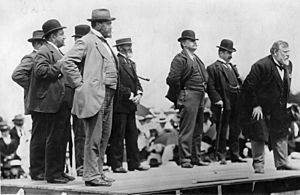
Seddon was a very strong leader. He made sure his authority was followed. He even once said that New Zealand only needed a "president" and that the Cabinet (group of ministers) could be removed. His opponents called him an autocrat, meaning someone who rules with total power. This is why he was called "King Dick."
Seddon took on many different roles himself. He was the Minister of Finance, Labour, Education, Defence, Māori Affairs, and Immigration.
He was also accused of giving jobs to his friends and allies, especially those from the West Coast. This is called cronyism. His enemies in the Liberal Party were often denied important positions. Many of the people Seddon appointed were not fully qualified for their jobs. He valued loyalty more than skill. There is a story that he appointed someone as a senior civil servant even though the person could not read. He was also accused of nepotism, which means giving jobs to family members. In 1905, there was a claim that one of his sons got an unfair payment, but this was proven false.
As Minister of Māori Affairs, Seddon tried to be helpful but also had a "paternalistic" approach. This means he acted like a father figure, deciding what was best for Māori people. As Minister of Immigration, he was known for his strong dislike of Chinese immigration.
Religion and Freemasonry
Seddon was an Anglican, a member of the Church of England.
He became a Freemason in 1868. Freemasonry is a social and charitable organization. In 1898, while he was Prime Minister, he was chosen as the Grand Master of New Zealand. He held this important role for two years.
Honours
Seddon attended Queen Victoria's Diamond Jubilee celebration in 1897. He received a special medal and was appointed to the Privy Council. In 1902, he attended the coronation of King Edward VII. He received another medal for this. During that same trip, he was given the "Freedom of the Borough" in his hometown of St Helens. He also received an honorary degree from the University of Edinburgh.
He was offered a knighthood twice but turned it down. He wanted to be seen as a "man of the people."
Death
Seddon was Prime Minister for 13 years. But as time went on, more people thought he should retire. There were attempts to replace him with Joseph Ward, but they failed.
In June 1906, Seddon was returning from a trip to Australia on a ship. He had a massive heart attack and died suddenly on 10 June. He was 60 years old, just 12 days before his 61st birthday. News of his death caused great sadness across New Zealand. Shops displayed black borders, and public monuments were created. Seddon was buried in Wellington's Bolton Street Memorial Park. His grave is marked by a large monument.
Joseph Ward was in London when Seddon died. He became the next Prime Minister almost two months later, on 6 August 1906.
Legacy
Many experts and historians consider Richard Seddon to be one of New Zealand's greatest prime ministers. He made the government's decisions very centralized around himself. He had almost complete control. In doing so, he made the role of Prime Minister the most important political job in New Zealand.
Seddon's son, Thomas, took over his father's seat in Parliament after his death. When Thomas met former US President Theodore Roosevelt in 1918, Roosevelt admired Richard Seddon. He especially liked the laws his government passed to help workers.
There is a statue of Seddon outside Parliament Buildings in Wellington. Another important statue is in the West Coast town of Hokitika. A town in New Zealand and a suburb of Melbourne, Australia, are named after him.
The Wellington Zoo started because Prime Minister Richard Seddon was given a young lion. Seddon created the zoo with this one animal. The lion was later named King Dick, after the Prime Minister. The stuffed body of King Dick (the lion) is now displayed at the Museum of Wellington City & Sea. St Mary's Church in Addington, Christchurch, also has a memorial bell tower for Richard Seddon.
A memorial to Seddon was unveiled in St Paul's Cathedral, London, in 1910. It has a portrait of Seddon and an inscription that says: "To the memory of Richard John Seddon prime minister of New Zealand 1893–1906 imperialist statesman reformer born June 22nd 1845 at St Helens Lancashire buried at Observatory Hill Wellington New Zealand."
Images for kids
See also
 In Spanish: Richard Seddon para niños
In Spanish: Richard Seddon para niños


